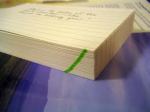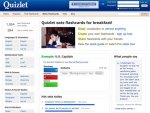This simple statement is a cornerstone of learning. Yet in too many classrooms the reverse is often true. Consider for a moment how many questions you ask your students versus how many questions or comments your students ask you or one other. The reality for most of us is that teachers ask most of the questions. Teachers too often are also the source of most of the writing and thinking that occurs in a classroom. Whether it’s a power point that students copy, or a student handout, or a worksheet, teachers are frequently seen as the font or the dispenser of knowledge. Often there is more teacher or publisher generated writing on a page of student work than there is student writing. Unfortunately this is not an efficient learning model. They require students to function at the lower levels of thinking and ensure that whatever information students do absorb will be gone within a day or two.
An effective classroom empowers all students to do most of the work. Most of us know this, yet these practices are not happening in many of our classrooms. Following are some simple suggestions and strategies to help shift the source of work in a classroom from the teacher to the student. These strategies redefine the role of the teacher (in the words of one of my colleagues) from a “sage on the stage” to a “guide on the side” as we facilitate student learning rather than dispense our own knowledge.
Strategy 1: Question Round Up
A Google search on Costa’s Levels of Thinking will give you a plethora of info, ideas, and even handouts on this inquiry tool. Personally I have moved away from using all but a single Costa’s poster. I found that my students were focusing too much on the stems and not on the thinking processes that define inquiry. Currently I give my students a description and a motion pattern of the thinking involved at each level. This makes Costa’s more portable (meaning students can use it wherever they are). I have found that physically representing each level of thinking as described below has increased the level and quality of the questions my students create. Here are the cues I use.
Level 1…answer is found in the text(source of info)
Action: Have one hand open in front of you and point to it with your other hand as you say these words.
Level 2…the source and you or source to source
Action:Same as for level one but after pointing to your hand point to your head. (Point an equal amount of time to both your hand and your head). Level 2 can also be source to source. (Point to one hand and then the other).
Level 3…mostly you.
Action:Sweep your finger quickly across the hand that represents the book and then point to your head.
Here’s a strategy that builds on this approach.
Instead of having students answer the questions from their text try the following. Remember when I say “text” I mean whatever the students are getting information from. This could be a web page, a video, a painting…virtually any source of information.
Have each student create 3 Level 1 questions and write them on a piece of paper making sure they skip at least five empty lines between each Level 1 question. Have them write Level 1 in front of each of these questions.
In groups of 3 have students rotate their papers.
Have students change the Level 1 questions on the paper they receive into Level 2 questions. They will record their level 2 question under the Level 1 question. Make sure they write level 2 in front of each of these questions.
Switch papers again. Now have the students change the Level 2 questions into Level 3 questions. Once again have them record the questions being sure to label them Level 3
Have students return each paper to the original questioner (the person who wrote the level 1 questions. Have each student choose to answer any of their group’s questions. Tell them that Level 1 questions are worth 1 point; Level 2 questions are worth 2 points; and Level 3 questions are worth 3 points. Choose a total point value that students must answer. For example students could answer 10 or 15 points worth of questions.
In order to ensure that all students are participating have students use different colored inks or initial every question they wrote.
Consider….Who did the work in this activity? Who did the learning?
Strategy 2: Two-Four-Talk-Write
This strategy is an effective way to have students read more deeply. I like to use it with big ideas such as the causes of a war. It could also be used for themes or essential concepts such as photosynthesis or as a way to tackle word problems.
First have students read a short piece of text…a page for example. In my case I had them use a reflective double entry journal on the War of 1812 and a page in their text book.
Next have elbow partners or pairs of students discuss the answer to a question you pose. Allow no more than two minutes for this.
Now have groups of 4 students discuss their response and come to a common response that one of them will present to the entire group.
Have the reporter from each group share their response. Ask clarifying questions where necessary.
Instruct the class to begin amending their notes to reflect the common elements of the responses they hear as each group reports out.
I like to make this portion more challenging by eliminating pronouns. This forces the reporting student to be certain about his or her response.
Repeat this process 3 more times so that each student has had a chance to report out. By the end of the day every student will have read carefully, collaborated with peers, and participated orally.
Complete the activity by having students complete a quick write based on a prompt that arises out of the topic. For example: Which cause of the War of 1812 was the most important? Why?
I evaluate each group based on the accuracy of their group response. This score is balanced by the individual quick write response.
Consider….Who did the work in this activity? Who did the learning?
Strategy 3: The Final Word
Summary is one of the most effective learning tools and yet it is so often misrepresented as paraphrasing. This strategy uses physical activity to help build students’ capacity to delineate essential ideas from supporting details and superfluous information. I recently used this to have students develop their understanding of the results of the War of 1812.
Have students sit in groups of 3-4. Have students fold a piece of lined filler paper in half and put their names in the large white margin at the top of the page.
Have students identify a recorder.
Provide students with a question that will allow them to synthesize or evaluate information.
Give students about 3 minutes to fill up the half page with as many ideas related to the answer as they can brainstorm.
Have each group share out their answers in the following manner.
- Group 1 shares everything they wrote on the half sheet.
- All other groups will highlight this information if they have it on their half sheet.
- If a group does not have this information they will add it to their half sheet and then highlight it.
- Group 2 shares all information on their half sheet that has not been highlighted. Once again all other groups highlight or add and highlight.
- Continue this process until all groups have presented their non-highlighted information
Now instruct each group to fold their half paper again (into fourths).
- Explain that each group now need to condense what is on the half sheet by writing the most important information onto the ¼ sheet.
- Explain that then the group will condense this information again and again as the sheet is folded into 1/8th and then 1/16th and then 1/32nd and then 1/64th of the sheet of paper.
- Explain that the last fold should only have one word on it
- Explain that every time the paper is folded a new group member will be the recorder.
Allow 5-10 minutes for this process of rotating the paper to a new recorder, folding the paper, discussing what should be written, and writing the response until only once word remains.
Finally share out the one word response from each group.
Collect and score each group’s completed folded paper.
Extension: Using the final word as the core of a topic sentence write a paragraph/essay that answers the original prompt.
Consider….Who did the work in this activity? Who did the learning?
I hope you try one of these. Let me know how it goes. I would also love to hear about your strategies that foster student ownership of learning as well.







